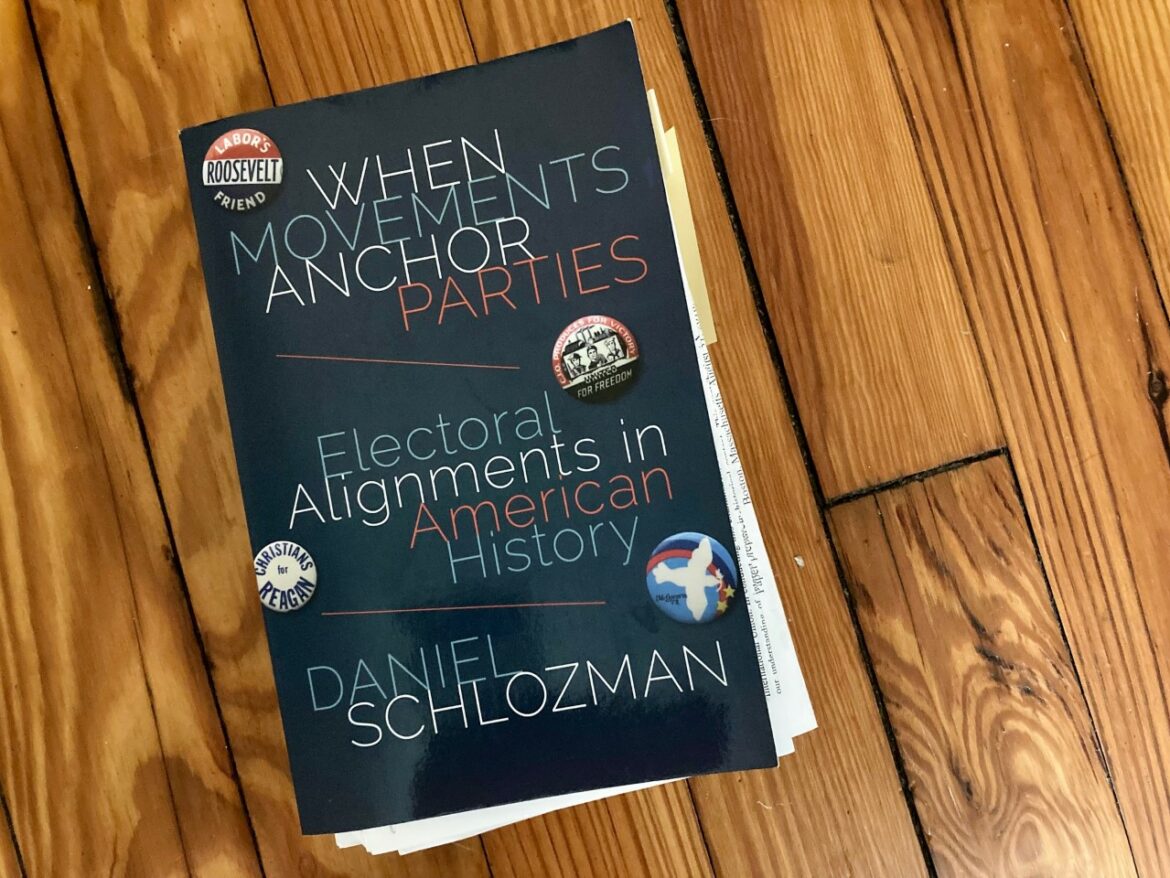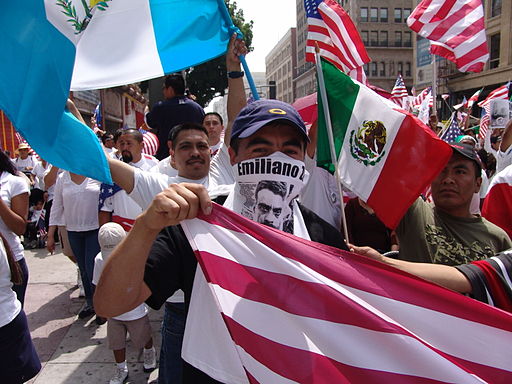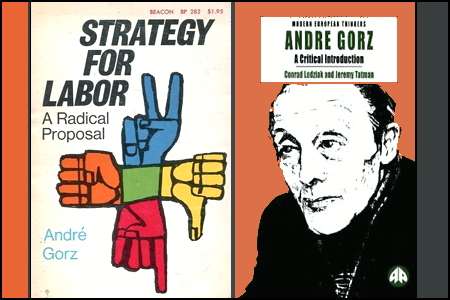Daniel Schlozman argues that, by becoming “anchor groups” within mainstream political parties, movements can secure lasting influence. But is entry into a party worth the price of admission?
By Mark Engler and Paul Engler
(Published on October 8, 2021 in The Nation)
* * * * *
If social movements want to have long-term power in the US, they must reckon with the state. And if they want to win control of the state, they must consider their relationship with political parties.
This is the argument Johns Hopkins political scientist Daniel Schlozman makes in his 2015 book, When Movements Anchor Parties. In recent years, we have witnessed some of largest mass protests in American history—from demonstrations of anti-Trump resistance to the uprisings that followed the killing of George Floyd—as well as robust organizing organizing around climate justice, #MeToo, immigrant rights, and other issues. In the wake of these upheavals, activists are debating how best to institutionalize gains over the long haul and how to interact with established political parties.
Rare among political scientists, Schlozman has looked at how social movements have shaped the agendas and ideologies of America’s major parties, drawing examples from both the left and right. Although written as an academic volume, When Movements Anchor Parties has drawn unusually wide interest in activist circles, particularly in groups such as Justice Democrats, which are attempting to elevate members of “the Squad” and other progressives—and thereby change the face of the Democratic Party.
“The fertile and contested meeting ground between political parties and social movements has made and remade American politics,” Schlozman contends. His research looks at the historical process by which some movements, such as organized labor in the 1930s and the Christian Right after the 1970s, became central parts of a governing coalition. He argues that, by becoming “anchor” groups within the Democratic and Republican parties, respectively, these movements secured ongoing influence. Schlozman also examines why other movements failed to become anchors, and how that diminished their impact over time.
Recently, we spoke with Schlozman to learn more about the reception of his book and the lessons that social movements today can draw from his research. Our conversation has been edited and condensed.
* * * * *
Mark Engler: In your book, you quote prominent mid-century political scientist E.E. Schattschneider, who argued, “A political party is an organized attempt to get control of the government.” You contend that movements for fundamental change in this country must therefore seek influence through alliance with a sympathetic party. Can you say more about what it means for a social movement to become an “anchoring group” in a political party?
Daniel Schlozman: In proportional representation systems, it’s easy to form parties, and social movements tend to form their own. So, for example, European social democratic parties emerge out of workers movements, and Green Parties emerge out of environmental activism.
But for various reasons—such as the Electoral College and first-past-the-post elections—the United States has an entrenched two-party system. Here, social movements don’t tend to do well when they form their own parties. We have a political system that is stacked against big change. And in this system, conflict largely takes place inside parties.
So what social movements typically do is try to convince existing major parties to advance their agendas. In exchange, they offer votes. They do this either directly—in terms of the supporters of a movement—or indirectly, through access to networks or money that a movement controls. This type of alliance was the story of both the labor movement in the 1930s with the Democratic Party, and the Christian Right with the Republican Party after the 1970s. Both become central pieces of a major party’s coalition. And then there are movements that couldn’t pull off that trick: the anti-war movement in the 1960s, and the Populists in the 1890s.
ME: You write, “With Populism died the most serious challenge to corporate capitalism that the United States would ever see. Although its personnel occupied positions at the top of the Democratic Party for decades, the antiwar movement failed to restrain American empire” in any substantial way.
DS: Right. The anti-war movement did not just want to end the invasion of Vietnam, it wanted to roll back the worst parts of American imperialism. As they aged, members of that movement became part of the new Democratic establishment, but there’s no actual organized movement that they brought with them. So there’s no real, ongoing dovish presence to push against American empire. It’s just not there. Instead, many of these politicians who might have identified as young activists in the ’60s become the liberal hawks of the 1990s and 2000s.
ME: You suggest a distinction between a movement that’s an anchor and a movement that’s merely serving as a pressure group. How would you characterize the difference?
DS: The classic thing that pressure groups do is work both sides. The pharmaceutical industry is a great example: They don’t really care about much of anything beyond securing profits. They will work with Democrats, and they will work with Republicans. Anchoring groups are more ideological. They have things to say about big issues. And they coordinate the preferences of the parties on the issues of foremost importance to them.
For example, how did we get to the world where the Supreme Court threatens basically to overturn Roe v. Wade? Answer: a party-wide project that has played out over a long, long time. This was not just the Christian Right treating abortion as one issue among many, where they were going to lobby legislators. By becoming an anchor and entering the Republicans, they shaped the whole worldview of the party around their priorities.
Paul Engler: So if an activist today asks you whether it’s worth aspiring to be an anchor group, as opposed to just being a pressure group, what would you say?
DS: That depends on what they want. If they want to persuade people one by one—for example to make more people vegetarians—then you don’t need to deal with the state. You want to work in civil society. Or if your goal is to affect some sliver of policy, you want to work with people on both sides, as needed.
But if your goal is to change the fundamental balance of forces in American politics—and that means grabbing the state by the collar—then that is when you want to be an anchor group.
ME: You mention a lot of movements that don’t quite fit your “anchoring” typology. We could look at the example of LGBTQ rights and the issue of same-sex marriage. This is not a movement that’s institutionalizing in the way you’re talking about. And yet they’re achieving serious policy gains—maybe even ones that go further than what the labor movement is getting through its alliance with the Democrats.
From environmentalism to the NRA and gun rights, to even the civil rights movement, these groups don’t exactly become anchors, and yet they have very significant legacies. Why shouldn’t movements today model themselves off of something like the civil rights movement?
DS: It’s not that they shouldn’t. They should—if that seems like the way that they can get what they want. But if what a movement wants is to change the distribution of political power, in a very direct sense, then some of the other paths to influence don’t work.
The LGBTQ movement succeeded through “elite persuasion” or “cultural persuasion.” If you have a group that is treated unsympathetically, which you want to be treated more sympathetically, figuring out how to do this kind of persuasion is smart. Now, I think there are limits to that—especially when it comes to influencing the distribution of power under capitalism. But movements can always ask: “Is what I want to do purely electoral politics, or is it more about reframing values and ideas and culture?” And, “Can I be effective by persuading through cultural rather than directly political means?”
I think that the LGBTQ movement is a good example of when culture is upstream from politics. I’m not sure I would have advised that movement correctly. I might have said, “Well, this culture stuff, it’s all kind of vague.” But I think they got that right.
However, when it comes to the state, party politics is always there. It always looms. So the question for activists is still, “how does it loom for me?”
PE: In terms of groups that might aspire to be anchors now, are there lessons they might draw from your research that could help them formulate strategy?
DS: Some of the pieces of advice are ones I wish I didn’t have to give: Most of the time movements lose. Changing things is harder than you think, and your victories are always partial.
What these past anchoring groups had, and what gave them their heft, was the ability to see over the horizon, to see what long-term change looks like. The labor movement in the 1930s had a genuine social vision—a vision of how they wanted to transform American life. The question of how to marry a vision of a world transformed with the practical exigencies of a nasty political system is very, very hard. But the game is worth the candle.
PE: You also highlight the role of the bridge figure who can negotiate between movements and political parties. In your book you write, “Parties and movements cannot magically join together. While conditions present the opportunity… to forge alliance, the real work falls to brokers, mid-level figures with deep ties spanning party and movement. They build coalitions from neither the top down nor the bottom up, but from the inside out and the outside in, stitching together different blocks of supporters and finding policies and candidates with appeal across them.”
DS: Exactly. It’s very valuable to have people who can both “think movement” and “think party”—who have some ability to translate the ideas and the strategic imperatives of each. Those are skills that have to be learned.
ME: You mention that there’s a real cost for movements attempting to institutionalize themselves within a political party: namely that activists will have to rein in some of their more visionary demands and they are often under intense pressure to abandon the more radical elements of their movements in order to sustain an alliance. You write: “Anchoring groups pay a high price to join together with parties.” But that, “given the rules of the game, it is a price well worth paying.” Can you comment on the price movements pay, and why you think it is worthwhile nonetheless?
DS: We see the price mostly clearly with the labor movement in the late 1940s. As the Cold War escalates, they have to push out the Communist unions that contain their most dedicated organizers. As for the Christian Right, they had to accept that they’re not building a Christian America; they had to accept that, within the party of Ronald Reagan, they would still play second fiddle to economic conservatives for a long time. Those are heavy prices.
In a vast country like the United States, change is really hard, and no small element is going to be a majority. And therefore you have to accept that you will lose a lot. If you start off with those elemental facts about American politics, then paying the price of alliance suddenly looks a lot more worth it than it might look if you’re just focused on immediate tactics.
ME: The Christian Right has been able to anchor within the Republican Party. But you also write that “its attempts to roll back cultural liberalism have met with little success.” Likewise, the labor movement has perennially failed to pass serious labor law reform. What is the benefit of being an anchor group if you’re still not meeting some of your key objectives?
DS: If you are not exercising influence inside the party, the risk is that the party will completely ignore your priorities and abandon you. One benefit of durable, long-term alliance is that you don’t get abandoned the minute your movement is no longer in the spotlight. The Christian Right has secured long-term benefits, even as its demographic share in the population stopped rising and as public religiosity declined. But in exchange for a durable alliance, you give up your freedom to say exactly what you want, when you want—because you have to protect your allies. So it becomes harder to deploy some of the oppositional tactics that social movements like to use.
PE: This is a great segue to talking about social movement theorist Frances Fox Piven. As you know, Piven’s model is that movements make gains through what she calls “disruptive dissensus,” which involves threatening to pull apart the coalitions that politicians have put together. In her account, politicians make concessions to avoid this type of disruption. Where do you agree with Piven and where do you disagree?
DS: I think the cold facts of the American political system are stacked against the left, and this suggests the need for a different kind of strategy than the full-on use of disruptive power that Piven recommends. There is a role for militancy, and there are certain moments when movements need to strike when the iron is hot. But it is not always the winter of 1934 for the labor movement. Outside of those select moments, there are real benefits to coalition and compromise.
PE: You say something interesting in your book about the timeline of social movements. We usually look at how movements emerge, formulate demands, seize the spotlight, and put issues on the public agenda. But the process of whether or not a movement becomes an anchor in a political party takes place after all that. This kind of institutionalization takes place outside the timeframe we usually pay attention to.
DS: Right. For a theorist like Piven, everything happens at these moments of crisis. But if you understand politics as something that happens over a series of decades, then you can’t really understand the ongoing influence of social movements unless you think of them all the way through this long lifecycle. You have to look at how movements can continue to exert influence. You have to look at how that influence is dependent on their mass base, but is often done through “regularized” means of electoral work and lobbying, even during lulls in protest.
PE: There does seem to be a tension here between the idea that politicians are valuing your ability to organize, your networks, your movement infrastructure—on the one hand—and the notion that, in order to enter into an alliance with a major party, you’re purging yourself of your best organizers. It seems like you’re shooting yourself in the foot. And certainly from Piven’s perspective, you’re giving up your ability to use disruptive power.
DS: I don’t disagree. But the question is always, what are the alternatives? And there are often fewer good alternatives than we might imagine.
ME: Along those lines, you write, “Maximalists who prize movement autonomy and confrontational tactics may… [wish] to continue to agitate from the outside. Such a decision augers enormous risk. No social movement has sustained effective militancy on a society wide basis… over decades. Passions fade; radicals and moderates split; organizations collapse.”
DS: Yes. Take the welfare rights example. The National Welfare Rights Organization was extremely impressive, but in many ways it was a house of cards. It fell apart quite quickly as it began to weaken. I think you need to build a mass base that’s more durable. And, like Bayard Rustin in his essay “From Protest to Politics,” I’m very much in the tradition that says electoral politics ultimately determines the success or failure of a movement.
ME: “From Protest to Politics” suggests a sort of linear progression. But another way of looking at this would be to use a more ecological perspective and say that you always have different actors and different branches in a movement that are oriented toward distinctive approaches. You will always have your insiders, and you will always have organizers focused on building structure-based organizations, and you will always have people who are doing disruptive protests. Those activities are all going on at the same time. So it’s not one or the other; it’s more about the interplay.
DS: I think that seems right. Movements always have their radicals and their moderates. And they may need both. But that doesn’t say exactly how radical the radicals should be, and how moderate the moderates should be—and whether or not they can actually work together.
I would say that people in movements should be aware of where they are in that spectrum and figure out how to support one another, and not eat each other alive. Because when they can’t work together, that’s really bad.











